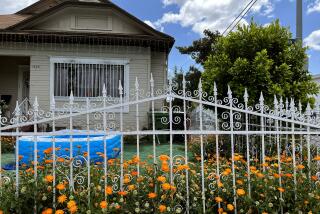When too many homes are castles
SAN CLEMENTE, former home of Richard Nixon -- now those people know how to fight a zoning war: Gallons of human poo furtively dumped in an enemy’s yard in the Shorecliffs neighborhood; the word “abortion” daubed across a hated house; little children cruelly struck from birthday party guest lists.
In Los Angeles, we’re still fighting our zoning battles on paper. So far.
Shorecliffs, says the Orange County Register, is at war with itself over second-story add-ons that block the views of the houses behind, whose owners then want to add a second story to regain their view, and so on until -- well, probably until San Bernardino.
Los Angeles’ equivalent war is over McMansions, the lotline-to-lotline monstrosities that can turn a green, airy neighborhood into a street as solid, massive and unfriendly-looking as the Raiders’ offensive line.
City Council member Tom LaBonge, who recently asked for stricter rules about building on hillsides and in canyons, now wants the planning department to answer that age-old question: How big is too big? Dump an 18-year patchwork of varying rules, he says, and set a standard for every teardown and every vacant lot that catches the eye of a builder.
I can’t say that I can actually hear the developers snickering, but LaBonge must have more faith in the process than I do. For years, some city building and safety officials have rattled the tin cup for contributions from developers for a “charity and special events” fund. They’ve been inclined to look on every project house by house, rather than as a piece of a neighborhood whole. They also have given fast-track treatment to some political insiders’ projects, and the head of the department was just ordered to tell a Superior Court judge why he shouldn’t be held in contempt for ignoring the city’s own rules when he approved a million-dollar home remodel in the Palisades.
Just how often do people complain that “L.A. has no neighborhoods”? Probably as often as other people set about trying to screw up the ones it does have. South Pasadena battled against a freeway that would slice it in half as neatly as the Black Dahlia. The Englishman who made the remark about every man’s home being his castle wasn’t being literal, but the Irishman who said that each man kills the thing he loves was.
The McMansion wars pit neighborhoods against builders, and sometimes family versus family.
The rich started it, of course. Aaron Spelling’s Holmby Hills mansion, with its mythic gift-wrap room and doll museum, is at least 1,000 square feet bigger than the White House; but then, a president only has to run the country; Spelling had to run a TV empire.
Trickle-down culture meant McMansions began appearing in ZIP Codes other than 90210 and its satellites. Families are smaller, but every one of them has to have four bedrooms, a home office, a room for Grandma and more space than George Washington required at Mount Vernon (the father of our country made do with 8,000 square feet; 9,000 if you count the back porch). And instead of the green yards beloved by earlier Angelenos, homeowners now gaze out their windows onto ... the neighbor’s McMansion.
Elsewhere in America, the houses are small and the people are fat. Here, the people are emaciated but the houses are huge -- often with more bathrooms than bedrooms, which suggests just how some residents stay so thin.
Other cities confronted this long before Los Angeles -- Glendale, Laguna Beach, San Marino, Westminster, Burbank, Rancho Palos Verdes. Even Beverly Hills has a lid on the house-to-lot-size ratio, though it’s more generous than historic-minded places such as Pasadena, whose Millionaires’ Row of a century past sat on land that could rightly be called grounds. Sure, land is expensive -- but cramming every last inch of it with house?
Thankfully, all this can reach its limits. I went to see a recently McMansionized Hollywood Hills house that is, I am assured, so overdone that it hadn’t sold even in the recent omnivorous market and is being rented out for porn shoots. I couldn’t see past the gates, the curlicues and the stonework and fancy lighting, but if that was any gauge, behind the gates was more of the same -- five bedrooms, seven bathrooms, nearly 7,000 square feet worth of over-the-topness.
THE TEAR-DOWN and build-over mega-house came upon us as another plague did 20 years ago -- the strip mall. Many communities finally put a stop to them, but not before thousands went up. (The biggest mini-mall-maker was La Mancha Development, with its Don Quixote logo. The builders thought the name was Spanish for “the impossible dream,” like the song. Instead it means a stain or a spot -- something disfiguring, which gets no argument from me.)
Los Angeles is a mutable place. Still, it has had some sense of scale and proportion, however inadvertent. So what would the place look like if everyone had a McMansion? Every street shoulder to shoulder in facades of stone or stucco, every home in perpetual shadow, perpetual airless proximity, perpetual lack of privacy. I’m getting the picture. Yes, I think I can imagine it now. It’s ... it’s
PATT MORRISON’s e-mail is [email protected].
More to Read
Sign up for Essential California
The most important California stories and recommendations in your inbox every morning.
You may occasionally receive promotional content from the Los Angeles Times.











